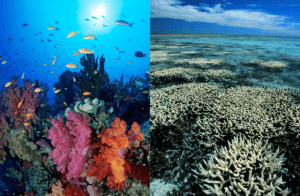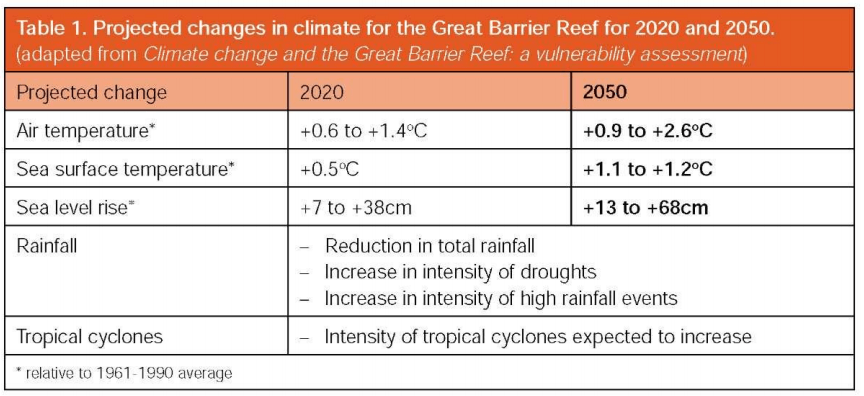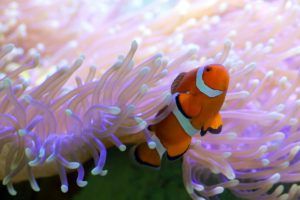Coral Reef or Coral DebReef?

Climate change is the #1 threat to coral reefs. Businesses in the tourism industry will be impacted negatively but can take action to mitigate the damage and minimize their own carbon footprint.
Background
The Great Barrier Reef (“GBR”), located on the east side of Queensland, Australia is the largest coral reef ecosystem on earth, covering 344,400 square kilometers, with biodiversity of over 3,000 species of coral reefs, and thousands of species of fish, molluscs, algae and other sea creatures [1]. Unfortunately, climate change has altered sea temperature and chemistry, leading to coral bleaching and the death of these algae. The most recent episode of coral bleaching in 1998-2002 bleached more than 50% of the reef [2]. As a result of climate change-induced coral bleaching could negatively impact the $5 billion Australian tourism industry, which currently provides jobs to 50,000 [1]. Key stakeholders, such as Big Cat Green Island Cruises, a GBR tourism operator and winner of the 2009 Climate Action Award from Ecotourism Australia [3], has taken initiatives to respond to climate changes and taken action to minimize its own carbon footprint in order to mitigate these changes.
How Does Climate Change Impact GBR
- Rising Sea Temperature
- Thermal stress causes the coral reef to expel symbiotic algae, Zooxanthellae, that live within their tissue. Zooxanthellae give reefs their bright color and most of their food and energy. Without the algae, the reef will appear white, hence “bleached”. Since 1978, the GBR has experienced eight massive coral bleaching since 1978 [2]
- Ocean Acidification
- More than ½ of carbon dioxide in the atmosphere gets absorbed by the ocean. The more carbon dioxide there is in the ocean, the lower the pH or more acidic the ocean becomes. The increase in CO2 is primarily caused by human activities such as the burning of fossil fuels. With low pH, corals cannot absorb the calcium carbonate they need to maintain their skeleton [4]
- Increase in Frequency of Severe Weather Events such as floods and cyclones/storms physically damage the coral reefs and causes imbalance in ocean biodiversity [1]
Projected Changes in Climate for 2020 and 2050 [1]
Threats of Climate Change on Tourism
Global warming increases the frequency of severe weather events, such as cyclones/storms, which have caused 34% of all coral death from 1995-2009 [4]. The erratic weather patterns diminish the quality of reefs, and increases variability in business operations through trip cancellations and rescheduling, which all negatively impact the number of visitors to GBR and therefore, the Australian tourism industry revenue. The current tourism activities will not be sustained neither environmentally or economically unless the tourism industry proactively responds to climate change.
Current Mitigation and Adaption Plans [5]
Big Cat Green Island Cruises is located in Cairns, Australia and is one of the largest GBR tourism operators, carrying over 100,00 passengers annually. The company has taken several climate change initiatives, including:
- Innovation of boat designs to reduce fuel consumption:
- Improvements to boat design, propellers, engines and speed have decreased fuel emissions from 95% of all emissions to 87%
- The catamaran design was cut in half and extended by 5 meters, reducing drag and adding 100 additional seats
- New Propellers, using four-stroke outboards and lower running speed saved 30% in fuel
- “Greener” Company Policy, including:
- Recycle and reuse materials
- Supply locally sourced and produced products
- Switch to biodiesel fuel
- Employee education and push for alternative transportation methods (walking, bike)
Recommendations for Further Actions [1]
Businesses in the tourism industry can proactively manage the impact of climate change by committing to the following:
- Raising Awareness and Educating Visitors: Operators can play a key role in helping visitors become more aware of climate change through educating them about the impacts of climate change on coral reefs. Operators can further positively influence visitor behaviour by encouraging them to reduce their own carbon footprint by making simple everyday changes
- Monitor and Report Changes: Collaborate with Government Agency, such as Great Barrier Reef Marine Park Authority (“GBRMPA”) and participate in programs such as Eye on the Reef, Sightings Network and BleachWatch to provide reef conditions reports
- Integrate Climate Change into Business Planning: develop risk management plans in preparation for significant events such as coral bleaching. Further diversification of business model to other tourism activities besides snorkeling and diving to minimize revenue fluctuation
Word count: 685
No mo’ nemo?
Citation
[1] “Great Barrier Reef Tourism Climate Change Action Strategy”. 2012. http://www.gbrmpa.gov.au/__data/assets/pdf_file/0009/3987/gbrmpa_CCActionStrategyFull_2011.pdf
[2] “Australia’s Biodiversity and Climate Change”. Australia Government https://www.environment.gov.au/system/files/resources/eab369d6-76f9-46c8-beb4-aaae8ece112e/files/biodiversity-vulnerability-great-barrier-reef.pdf
[3] “Climate Change and Tourism in the Great Barrier Reef Marine Park” 2011. https://www.researchgate.net/publication/233442544_Climate_change_and_tourism_in_the_Great_Barrier_Reef_Marine_Park
[4] Australian Government Great Barrier Reef Marine Park Authority. http://www.gbrmpa.gov.au/
[5] The Big Green island Reef Cruises Company Website. http://greenisland.com.au/our-company/environment/
Images:
http://thistinyplanet.org/wp-content/uploads/2016/06/coral_bleach2.png
http://geographical.co.uk/media/k2/items/cache/1706b33fef7712ba31cca5e36abb2536_XL.jpg






The threat posed by Climate Change on ocean biodiversity and in particular coral reefs is indeed very real. It is great to see that companies like Big Cat Green Island Cruises are taking this seriously and making significant efficiency savings. These savings however, have a direct impact on the company’s bottomline in the long term – would they be as quick to implement if this was not the case?
An interesting article that I read over the summer speaks of Scuba Divers’ ability to help combat climate change affects on coral reefs by being helping to measure water temperatures whilst diving. See article: https://www.deeperblue.com/scientists-dive-computer-can-play-role-measuring-ocean-temperatures-climate-change/
This additional information could help to close the data gap and decrease the amount of money (and carbon footprint!) associated with putting buoys in the water that help to measure and track changes in temperature. They can also provide richer data by recording temperature for different depths in the water rather than simply on the surface.
The sad thing is that the climate change impact on coral reefs is not only a problem for the Australian tourism industry and economy. We do not know the chain reaction that could be triggered by significant damage to the habitat of so many underwater species.
I agree with Shpiro20. I’m glad to hear relevant companies actively trying to fight global warming especially in tourism, but there has been very few examples of eco-tourism sites that I believe are really trying to educate sustainability and offer tourism successfully. One of the sites I’ve experienced that really nailed it was Wakatobi Dive Resorts in Indonesia (https://www.wakatobi.com/).
The founder of the resort is an ecologist, who believed that the specific combinations of wind, temperature, and currents at these specific cluster of islands would be the perfect place to do research in marine biodiversity. Supported by his two brothers, the resort now stands as more of a retreat: all guests are open to join lectures about the sea and its corals. But education is just the cherry on top- the bulk of support you’ll be giving is by the price of the stay. They’re very transparent about where the money goes to, and how you can get involved. There may be a controversy here because of the limited impact due to its exclusivity, but one can also argue they’re highly targeted in their marketing.
It’s great to hear that Big Cat Green Island Cruises is doing its part to mitigate its environmental impact in such a sensitive area. In addition to data collection for the scientific community as Shpiro20 mentioned, I wonder if this presents a good opportunity for Big Cat Green to influence the general public to do their part as well. I imagine that using social media to circulate before and after photos would be an incredibly powerful tool to raise awareness and inspire action. To the general public, I think that temperature and species loss data can seem abstract, and Big Cat Green is in a fairly unique position to provide visuals that they can better connect with.
A world without Nemo sounds like a terrible, terrible place!
According to a report by the Australian Government [1], not all coral reefs will be equally affected by climate change. Perhaps government agencies like the Great Barrier Reef Marine Park Authority should focus on protecting the areas that will be least affected by climate change, as some reefs may already be too far gone. The same article cited above states that 16% of the world’s coral reefs are already seriously damaged. By pooling resources around the most protected coral reefs, we may be able to better allocate our dollars towards an effective attack against climate change.
Additionally, I suggest building out your first initiative of awareness and education by also teaching people about what coral reefs do for animals. So many animals and organisms depend on coral reefs for shelter and food. Our entire underwater ecosystem will be thrown off if any more damage is done. People need to be aware that this is a huge problem, and it’s not just about the coral reefs.
[1] Australia’s Biodiversity and Climate Change
https://www.environment.gov.au/system/files/resources/eab369d6-76f9-46c8-beb4-aaae8ece112e/files/biodiversity-vulnerability-great-barrier-reef.pdf
For obvious reasons, this issue is near and dear to my heart – I’m glad that you covered it Mary. The phrase ‘ocean acidification’ sounds too big to tackle. I am concerned that there aren’t more localized initiatives that will lessen coral bleaching. Perhaps this is because the are no quick wins this space. One interesting idea that I discovered after reading Kelly’s review on the Oyster Industry was that kelp absorbs CO2 which helps to neutralize water acidity. I am not sure if the conditions around the great barrier reef are conducive to kelp growth but it would be interesting to find out. Additionally, I wonder if there are any other strategies that exist that actively combat ocean acidification. It seems as if there is much work to be done in this space.
+1 to Kelly’s sentiment: no mo’ nemo would be a tragedy 🙁
I agree with the rationale behind your recommended action plan of raising awareness and educating visitors, but I wonder if this company more urgently needs to do more to generate awareness and drive interest in order to bring visitors in in the first place. For example, could this company invite a popular travel blog or magazine to profile them and discuss how climate change is impacting the reefs and what they as a company are doing to respond. Would generating / capitalizing on some coral reef FOMO be effective? For example, when I climbed Kilimanjaro, I learned that the snow on top of the mountain would likely melt within 5 years (also referenced here: http://www.cctv-america.com/2014/07/25/climate-change-famous-mount-kilimanjaro-snow-disappearing), which some of the travelers I talked to cited as a reason they decided to make the trip when they did.
Thanks for the interesting piece, Mary. I also wrote about the importance of restoring coral reefs considering climate change. I was focused more on the coral reefs as barriers protecting human population centers, rather than coral reefs as tourist attractions, but the sentiments are similar.
I agree with your suggestion that Big Cat Green Island Cruises should collaborate with government agencies to amplify its efforts. I don’t think Australia is as susceptible to extreme weather as the Caribbean is, but I suspect that the Australian government would be even more receptive to helping if private companies demonstrated that the reefs had an essential protective function beyond tourism.
I was also intrigued by Kelly’s comment that some reefs may be too far gone to save. I assume that BCGIC is focusing its cruises on the reefs that are less badly damaged. If that is the case, perhaps BCGIC and other private players can spend their money rehabilitating the reefs that they are receiving the most economic benefit from. The Australian government could focus its efforts on restoring some of the more damaged reefs that may no longer have tourist value, but still have protective and ecological benefits to the Australian continent if restored.
Even with Big Cat Green Island Cruise’s efforts, the effects of global climate change are externalities from the whole world. While its good they are taking actions, I think there efforts might be better spent in raising awareness as you suggested. If they do want to take steps themselves, I wonder if they could move to sailboats or even greener means of transporting to do better than just 8% reduction. Even wilder, I wonder if they could create a different experience to share the GBR’s with the world through videos or more immersive Augmented Reality.
I wonder if there are ways to replace the Zooxanthellae as a stop gap measure. This won’t fix the problem, but perhaps could prevent the bleaching in the short term until we can reverse negative impacts from climate change.